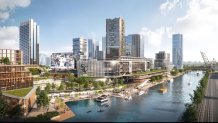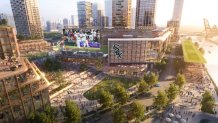A new Chicago White Sox stadium could be one step closer to reality as the team's chairman Jerry Reinsdorf is set to meet with legislative leaders in Springfield Tuesday in hopes of securing public funding for the project, multiple sources tell NBC Chicago.
According to sources, Reinsdorf Tuesday will meet with Democratic and Republican leaders as he seeks $1 billion to construct a new White Sox Stadium at "The 78" in the South Loop.
Crain's Chicago Business first reported on Friday that the team was preparing to ask for $1 billion in public dollars, but that Reinsdorf had yet to meet with Gov. J.B. Pritzker. However, the report stated the White Sox have been in contact with state officials on the subject.
"The two [Reinsdorf and Related Midwest President Curt Bailey] are bullish they can win state support by arguing the stadium subsidies will bring along billions more in private investment, and the deal is structured in a way to not require new or increased taxes," Crain's reported.
Earlier this month, Pritzker commented of real estate firm Related Midwest's latest stadium renderings, but expressed skepticism, noting that the state needs "to be careful with public dollars."
Reinsdorf however is reportedly confident in his chances of winning over the state's approval for his complex financial plan to fulfill the goal of building an entirely new Sox stadium, in collaboration with real estate firm Related Midwest, along the Chicago River.
What could a new Chicago White Sox Stadium look like?
Chicago White Sox
The onus of the plan is to create private investment funds from housing, bars, restaurants, a 4,000-spot parking garage and parks around the stadium from the state subsidy to create funding back to the state.
The plan also projects five million annual visitors, a $9 billion investment in Chicago, $4 billion stabilized annual economic impact, 32,000 jobs, 1,000 affordable units, $200 million annual tax revenue, 10+ acres of space for the community and 1,300 residential units.
Feeling out of the loop? We'll catch you up on the Chicago news you need to know. Sign up for the weekly Chicago Catch-Up newsletter.
A move to "The 78" would see the White Sox leave their longtime neighborhood for the first time, moving the club to a plot of land in the South Loop bordered by Roosevelt Road on the north, the Chicago River to the west, Clark Street to the east and train tracks near Ping Tom Park to the south. Wells Street would run through the planned development.
The area would feature considerable public transit access, with three CTA lines stopping right at Roosevelt and State Street, just a couple of blocks east of the property: the Red, Green and Orange Lines.
Several bus lines also provide close access to the area: the 3, 4, 12, 18, 24, 29, 62, 130, 146 and 157 lines. For fans who want a ride down the river, there is also a water taxi stop at Ping Tom Park.
The team's current lease, at Guaranteed Rate Field in Bridgeport, expires following the 2029 season.
Here's a look at what the new stadium could look like:



How the money breaks down
The White Sox hope to use a 2% hotel occupancy fee — meant to pay ISFA’s [Illinois Sports Facilities Authority, a government entity used for constructing sports stadiums, including the White Sox' Guaranteed Rate Field] annual debt service for their bonds towards the White Sox' stadium and the Bears' 2003 renovations to Soldier Field — "for decades beyond when all outstanding bonds are currently meant to be paid off in 2034."
The report indicates the Chicago Bears — who are also seeking the IFSA's assistance in building a new stadium at either Arlington Heights or the Chicago lakefront — have not met with the White Sox to create a joint plan. The two teams will fight for the opportunity to collaborate with the IFSA for their respective stadium plans.
The plan includes extending the IFSA's bonds by 30 years, while adding a line of revenue through the aforementioned private investments, which should be enough to cover starting capital for the stadium, according to the report.
"The new ballpark is a very, very important engine for this investment, but it is a smallish component as an overall dollar amount of the project that will in many ways change the face of the city of Chicago,” a source involved in the meetings told Crain’s.
Reinsdorf also, according to the report, wishes to use the sales tax generated from the surrounding area to not only subsidize the stadium, but allow for new IFSA bonds. That sales tax, according to the report, would give Reinsdorf the funds needed to build a stadium, and also satiate the current IFSA debt.
Of the $399 million the IFSA funded towards the Bears, $384 million is still outstanding.
The extensive, complex plan needs state approval, which will be the most difficult part of the plan. Pritzker, much like other state politicians, is hesitant to use public funding on stadiums, as it rarely creates positive dividends for the city/state.
The IFSA would certainly need to co-sign the plan, too, as the adjustments to their bonds are drastic. The plan leaves Guaranteed Rate Field unaccounted for, which they are on the hook for paying.


